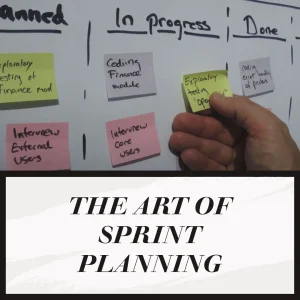Introduction to Agile and Remote Teams
The adoption of agile methodology has become increasingly vital, especially as remote teams gain prominence. This section will define agile methodology, discuss the rise of remote teams, and highlight the necessity of agile practices in addressing the unique challenges posed by remote work.
Defining Agile Methodology and Its Core Principles
Agile methodology is a project management approach that emphasizes flexibility, collaboration, and customer-centricity. It is characterized by several core principles outlined in the Agile Manifesto, which include:
- Individuals and Interactions Over Processes and Tools: Agile prioritizes effective communication and collaboration among team members, which is crucial in a remote setting where face-to-face interactions are limited.
- Working Software Over Comprehensive Documentation: Agile focuses on delivering functional products incrementally, allowing teams to adapt to changes quickly and efficiently.
- Customer Collaboration Over Contract Negotiation: Agile encourages ongoing engagement with stakeholders, ensuring that the project aligns with customer needs and expectations.
- Responding to Change Over Following a Plan: Agile embraces change as a natural part of the project lifecycle, enabling teams to pivot and adjust their strategies as necessary.
These principles foster an environment where teams can respond swiftly to challenges and opportunities, making agile particularly relevant for remote project management.
The Rise of Remote Teams in Project Management
The shift towards remote work has accelerated in recent years, driven by technological advancements and changing workforce dynamics. Organizations are increasingly adopting remote teams to tap into a global talent pool, reduce overhead costs, and enhance work-life balance for employees. This trend has been further propelled by the necessity of remote work during global events, such as the COVID-19 pandemic, which forced many teams to adapt quickly to virtual collaboration.
As remote teams become the norm, project managers face unique challenges, including:
- Communication Barriers: The lack of physical presence can lead to misunderstandings and misalignment among team members.
- Time Zone Differences: Coordinating schedules across different time zones can complicate collaboration and decision-making.
- Isolation and Engagement: Remote work can lead to feelings of isolation among team members, impacting morale and productivity.
The Need for Agile Practices in Overcoming Remote Work Challenges
Given the challenges associated with remote teams, agile practices offer a robust framework for enhancing project management effectiveness. By implementing agile methodologies, remote teams can:
- Enhance Communication: Regular stand-up meetings, sprint reviews, and retrospectives foster open dialogue and ensure that all team members are aligned on project goals and progress.
- Increase Flexibility: Agile’s iterative approach allows teams to adapt to changing requirements and feedback, which is essential in a remote environment where conditions can shift rapidly.
- Boost Engagement: Agile practices encourage team collaboration and ownership, helping to mitigate feelings of isolation and fostering a sense of community among remote workers.
The integration of agile methodology into remote project management not only addresses the inherent challenges of distance but also enhances overall team performance and project outcomes. As remote teams continue to grow, embracing agile practices will be crucial for project leaders aiming to navigate this new landscape effectively.
Key Characteristics of Agile Methodology
Adopting agile practices can significantly enhance team dynamics and project outcomes. Here are the essential characteristics of agile methodology that remote teams can leverage to overcome challenges and improve efficiency:
- Iterative Development and Continuous Feedback: Agile emphasizes short development cycles, known as iterations, which allow teams to deliver small, incremental improvements. This approach facilitates continuous feedback from stakeholders, enabling teams to make necessary adjustments quickly. For remote teams, this means that regular check-ins and reviews can help maintain alignment and ensure that the project is on track, even when team members are geographically dispersed.
- Collaboration and Communication as Cornerstones: Effective collaboration and communication are fundamental to agile practices. Agile methodologies encourage frequent interactions among team members, which can be achieved through daily stand-ups, sprint planning, and retrospectives. For remote teams, utilizing digital tools such as video conferencing, chat applications, and collaborative platforms can foster a culture of open communication, ensuring that everyone is engaged and informed.
- Flexibility and Adaptability to Change: One of the core principles of agile is the ability to respond to change over following a fixed plan. This flexibility is particularly beneficial for remote teams, as it allows them to pivot quickly in response to new information or shifting project requirements. By embracing change, remote teams can better navigate uncertainties and deliver value more effectively.
- Customer-Centric Approach and Stakeholder Involvement: Agile methodologies prioritize customer satisfaction by involving stakeholders throughout the project lifecycle. This characteristic encourages remote teams to seek regular input from clients and users, ensuring that the final product meets their needs. Engaging stakeholders in the development process not only enhances the quality of the deliverables but also strengthens relationships and trust.
- Self-Organizing Teams and Accountability: Agile promotes the concept of self-organizing teams, where members take ownership of their tasks and collaborate to achieve common goals. This characteristic empowers remote teams to make decisions independently, fostering a sense of accountability and motivation. By trusting team members to manage their work, leaders can create an environment that encourages innovation and productivity.
By understanding and implementing these key characteristics of agile methodology, remote team leaders and project managers can effectively navigate the complexities of remote work, enhance collaboration, and drive successful project outcomes. Embracing agile practices not only improves team dynamics but also ensures that projects remain aligned with customer needs and market demands.
Challenges Faced by Remote Teams
Remote teams often encounter unique challenges that can hinder their effectiveness and productivity. However, adopting agile practices can help address these issues and enhance project management. Here are some specific challenges faced by remote teams:
- Communication Barriers and Misalignment: In a remote setting, team members may struggle with effective communication due to time zone differences, lack of face-to-face interaction, and reliance on digital tools. This can lead to misunderstandings, misalignment on project goals, and delays in decision-making. Agile practices, such as daily stand-ups and regular check-ins, can foster open communication and ensure that everyone is on the same page.
- Isolation and Reduced Team Cohesion: Remote work can lead to feelings of isolation among team members, which may affect morale and collaboration. The lack of in-person interactions can diminish team cohesion and trust. Agile methodologies emphasize teamwork and collaboration through practices like pair programming and collaborative planning sessions, which can help build stronger relationships and a sense of belonging among remote team members.
- Difficulty in Tracking Progress and Productivity: Monitoring progress and productivity can be challenging in a remote environment, where traditional oversight methods may not be effective. Agile frameworks, such as Scrum or Kanban, provide visual tools like boards and burndown charts that help teams track their work and progress transparently. This visibility allows team leaders to identify bottlenecks and adjust workloads accordingly.
- Adapting to Changing Project Requirements: Remote teams often face rapidly changing project requirements due to market dynamics or stakeholder feedback. Agile practices promote flexibility and adaptability, allowing teams to respond quickly to changes. Regular sprint reviews and retrospectives enable teams to reflect on their work and make necessary adjustments, ensuring that they remain aligned with project goals and client needs.
By recognizing these challenges and implementing agile practices, remote teams can enhance their collaboration, productivity, and overall project success. Embracing agility not only addresses the inherent difficulties of remote work but also empowers teams to thrive in a dynamic environment.
Applying Agile Characteristics to Overcome Remote Challenges
Agile methodologies offer a robust framework to address common challenges faced by teams. By leveraging key agile characteristics, remote team leaders and project managers can enhance communication, collaboration, and overall project success. Here are some practical examples of how these characteristics can be applied effectively:
- Daily Stand-ups and Virtual Meetings: One of the core practices of agile is the daily stand-up, a brief meeting where team members share updates on their progress, challenges, and plans for the day. In a remote setting, this can be adapted to virtual meetings using video conferencing tools. These daily check-ins not only keep everyone informed but also foster a sense of connection and accountability among team members. By maintaining a consistent schedule for these meetings, teams can enhance communication and ensure that everyone is aligned on project goals.
- Implementing Agile Tools for Better Collaboration: Utilizing agile project management tools such as Trello, Jira, or Asana can significantly improve collaboration among remote teams. These platforms allow team members to visualize project progress, assign tasks, and track deadlines in real-time. By centralizing information and providing a clear overview of the project status, these tools help mitigate misunderstandings and ensure that all team members are on the same page, regardless of their physical location.
- Encouraging Iterative Feedback Loops: Agile emphasizes the importance of iterative development and continuous feedback. Remote teams can implement regular review sessions or sprint retrospectives to gather input from team members and stakeholders. This practice not only helps in identifying areas for improvement but also ensures that the project remains aligned with client expectations and team capabilities. By fostering an environment where feedback is welcomed and acted upon, teams can adapt quickly to changes and enhance their overall performance.
- Fostering a Culture of Trust and Accountability: Agile methodologies promote self-organizing teams, where members take ownership of their tasks and collaborate to achieve common goals. In a remote setting, it is crucial to cultivate a culture of trust and accountability. Leaders can encourage this by empowering team members to make decisions, share their expertise, and support one another. Recognizing individual contributions and celebrating team successes can further strengthen this culture, leading to higher morale and productivity.
By integrating these agile characteristics into remote project management practices, teams can effectively navigate the unique challenges posed by distance and enhance their overall performance. Embracing agile not only improves communication and collaboration but also fosters a resilient and adaptive team environment, essential for success in today’s dynamic work environment.
Tools and Techniques to Support Agile in Remote Teams
Adopting agile practices can significantly enhance team collaboration, productivity, and adaptability. Here, we explore essential tools and techniques that facilitate agile methodologies in a remote setting, ensuring that teams can effectively navigate challenges and maintain momentum.
Overview of Popular Agile Project Management Tools
- Asana:
- Features: Asana is a versatile project management tool that allows teams to create tasks, set deadlines, and track progress through various views such as lists, boards, and calendars. Its integration capabilities with other tools enhance workflow efficiency.
- Benefits: Asana’s user-friendly interface and customizable templates make it easy for remote teams to manage projects and prioritize tasks effectively.
- Monday.com:
- Features: This platform offers a highly visual approach to project management, enabling teams to create workflows that suit their specific needs. It includes features like time tracking, automation, and reporting.
- Benefits: Monday.com fosters transparency and accountability, allowing team members to see project statuses at a glance, which is crucial for remote collaboration.
- Trello:
- Features: Trello uses a card-based system to organize tasks and projects. It is particularly effective for visualizing workflows and managing tasks in a kanban style.
- Benefits: Its simplicity and flexibility make Trello an excellent choice for teams looking to implement agile practices without overwhelming complexity.
- Jira:
- Features: Designed specifically for software development teams, Jira supports agile methodologies like Scrum and Kanban. It offers robust tracking and reporting features.
- Benefits: Jira’s focus on agile project management makes it ideal for teams that require detailed tracking of sprints and backlogs.
Techniques for Remote Teams
- Time-Boxing:
- Definition: Time-boxing involves setting fixed time periods for specific tasks or activities. This technique helps teams maintain focus and manage their time effectively.
- Application: Remote teams can implement time-boxing during meetings or work sessions to ensure that discussions remain productive and that tasks are completed within the allocated time.
- Retrospectives:
- Definition: Retrospectives are regular meetings where teams reflect on their performance, discuss what went well, and identify areas for improvement.
- Application: Conducting virtual retrospectives allows remote teams to foster a culture of continuous improvement. Utilizing video conferencing tools and collaborative documents can enhance participation and engagement.
Best Practices for Virtual Collaboration and Documentation
- Establish Clear Communication Channels: Utilize tools like Slack or Microsoft Teams to create dedicated channels for different projects or topics. This helps streamline communication and ensures that team members can easily access relevant information.
- Utilize Collaborative Documentation: Tools like Google Docs or Confluence enable real-time collaboration on documents, making it easier for remote teams to share knowledge and maintain up-to-date project documentation.
- Regular Check-Ins: Schedule regular one-on-one and team check-ins to maintain connection and accountability. These meetings can help address any challenges team members may face and keep everyone aligned on project goals.
- Visual Management: Use visual tools like Miro or Lucidchart to create shared boards for brainstorming and planning. Visual aids can enhance understanding and engagement during remote meetings.
By leveraging these tools and techniques, remote teams can effectively implement agile practices, overcoming the unique challenges posed by distance and fostering a collaborative and productive work environment. Embracing these strategies not only enhances project management but also strengthens team dynamics, leading to successful project outcomes.
Conclusion: Embracing Agile for Remote Success
The adoption of agile practices has become increasingly vital. As teams navigate the complexities of working from various locations, agility offers a framework that not only enhances collaboration but also drives project success. Here are some key points to consider:
- Importance of Agility: Agility in remote project management allows teams to respond swiftly to changes and challenges. By embracing iterative processes, remote teams can adapt their strategies based on real-time feedback, ensuring that they remain aligned with project goals and client expectations. This flexibility is crucial in a remote setting where communication barriers can often lead to misunderstandings or delays.
- Encouragement to Embrace Agile Characteristics: Team leaders are encouraged to adopt core agile characteristics such as collaboration, transparency, and continuous improvement. By fostering an environment where team members feel empowered to share ideas and feedback, leaders can cultivate a culture of innovation and accountability. Agile methodologies, such as Scrum or Kanban, can provide structured frameworks that facilitate these characteristics, making it easier for remote teams to stay engaged and productive.
Embracing agile practices is not just a trend but a necessity for remote teams aiming for success. By prioritizing agility, team leaders can navigate the challenges of remote work more effectively, ensuring that their projects are delivered on time and to the highest standards. Now is the time to take action and integrate agile methodologies into your remote project management strategy for enhanced performance and collaboration.
Find out more about Shaun Stoltz https://www.shaunstoltz.com/about/.
This post was written by an AI and reviewed/edited by a human.



